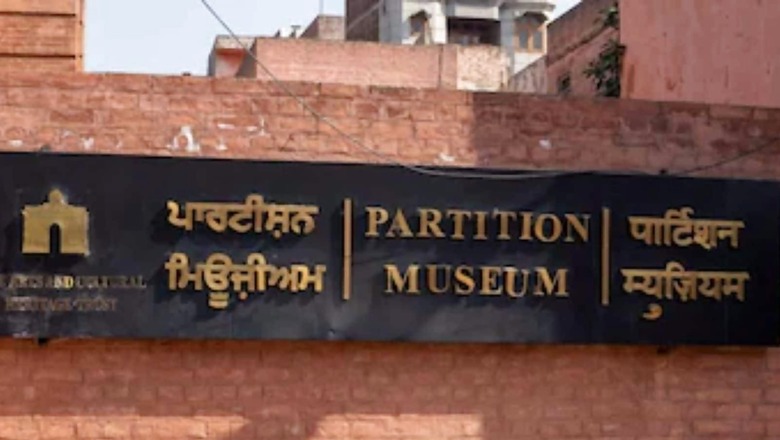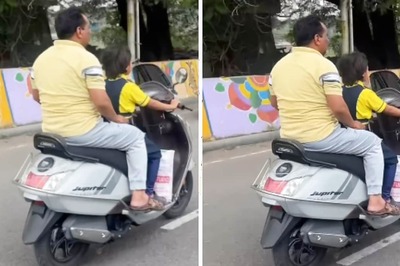
views
Belonging to a refugee family from West Punjab, I grew up with the pain of being uprooted from our native place with a thought of going back there one day. Being a third-generation swayamsevak of the Rashtriya Swayamsevak Sangh (RSS), I also grew up with a belief of re-establishing Akhand Bharat or undivided Bharat.
Listening to the woes of Partition from family elders have always been very painful. A few of them would tell how every paisa earned through sheer hard work was snatched overnight. Others would tell how half of the family was left behind and got killed. I still remember one of the elders telling the story of living in Pakistan’s Rawalpindi even after 15 August, converting to Islam to get back one of the female family member. I lived in a colony where we had Pishorian De Hatti (a shop run by a Peshawar Hindu refugee), a Sindhu Samaj building and a Bahawalpur Bhawan.
The Sikhs and Hindus of now Pakistan were getting signals from majority Muslims about “Raliv, galiv Ya chaliv” since the 1920s. But they remained naive enough to ignore or disbelieve this. Forceful conversions were happening since the early 1920s in areas like Peshawar, Okara, Sheikhupura, Gujranwala, Lyallpur, Derawal, Mianwali, Toba Tek Singh, Dera Ismail Khan, Dera Ghazi Khan, etc.
I recently wrote about two Hindu genocides and a few friends reminded me of Hindu and Sikh genocides of west Punjab and Sindh. Probably most of us don’t know about the genocides that happened in North Western Frontier Province and places like Jhang and Multan. In one of the rare books written by Sardar Gurcharan Singh Talib and published by SGPC Amritsar in 1950, the author has covered a few of these genocides during August and September 1947. Most of the places mentioned above were generally controlled by non-Muslims and had flourishing businesses and agricultural setups.
Partition is story of deceit and deception by the Congress leadership and the latter’s unconditional surrender to Muslims and the Muslim leadership. This surrender started in 1923, when Pandit Vishnu Digambar Paluskar was interrupted while singing Vande Mataram; meanwhile, Mahatma Gandhi supported Mohamad Ali Johar, the then president of the Congress, culminating with Partition. This was not due to Muslim League politics but was part of larger Muslim politics.
ZA Bhutto, in his book History of Pakistan: Past and Present, begins the story of Pakistan with “the advent of Islam”. He tells us that the “starting point of Pakistan goes back over thousand years when Muhammad bin Qasim had set foot on the soil of Sind and introduced Islam in the subcontinent”. Muslim scholars have also their own idea and version of Muslims’ freedom struggle and they equate it with the Muslim empire. It began when Muslim lost their empire after Aurangzeb and partially ends with the establishment of Pakistan. Pakistan’s official “history of the freedom movement of Muslims in the India-Pakistan subcontinent covering the period from death of emperor Aurangzeb in 1707 to the establishment of Pakistan in 1947” reveals their approach. Alas, our leadership was and still not able to recognise this.
The crimes committed by Muslims and the Muslim League on this part of the country are unpardonable and unforgettable. Whole villages and towns were wiped out with meticulous planning. Mobs were organised in the name of Deen by the Muslim League, Muslim police, administration and military helped committing genocide of Hindus and Sikhs. In the Kamoke massacre, 5,000 people were picked on pretext of being sent to safer locations; the Parachinar massacre saw 1000 people killed; most gruesome of them all was the Sheikhupura massacre where the whole populace of 15,000 was killed, raped and abducted. The Sharaqpur massacre, Gujranwala massacre, Muzaffarabad massacre, the Mirpur-kotli massacre are the other few.
The exact number of Hindus killed is still not known. The most gruesome being the Sheikhupura massacre; it still sends chills down the spine. Here is a brief description. A communal riot had never taken place in the history of Sheikhupura. It was considered a non-Muslim stronghold. The town had a majority of Hindus and Sikhs. In this district Muslims were 68 percent, Hindus 12 percent and Sikhs 20 percent. But the Sikhs were the most formidable community in the district. They considered this district as their stronghold. The most important Sikh shrines of Nankana Sahib and Sacha Sauda were located in the district. Even after the announcement of the Mountbatten Plan of the Partition of Bharat, Hindus and Sikhs did not evacuate this district. Rather from the neighbouring districts of Gujranwala non-Muslims thought it safer to come here. The tehsil and town were considered to be safe centres for Hindus and Sikhs. Muslims declared solemnly before and after 15 August to protect with their lives, the life honour and property of non-Muslims. The partition of Punjab and the option exercised by the officers had removed all the non-Muslim official. All the magistrates, other civic officials and police were Muslims.
Even the contingent of Boundary Force stationed was purely Muslim. On 24 August 1947, for the first time in the history of Sheikhupura curfew was imposed by the district magistrate. At the dead of night, a house was set ablaze and the Muslim military watched as to who came to douse the fire, so that he might be shot down. Only two men could be shot that night. On 26 August at 2 pm again, the curfew was imposed. All the petrol pump owners were summoned by the administration and ordered to give all the petrol in the name of an emergency. The Muslim shop owners in the vicinity of Hindus and Sikh shopkeepers had been told to vacate their shops. After the imposition of curfew, the Muslim Magistrate, Qazi Ahamad Shafi, leading the military started from one end of Sheikhupura and began to March through the town. Their work was very systematic and done with military precision. They systematically killed all men and old women, and abducted young girls. A second party followed, looting the property and setting fire to the houses of non-Muslims. Some Hindus and Sikhs strangled their girls and threw them into wells to save them from dishonour. In another incident Hindus and Sikhs were gathered; women were put in one line, and men in the other. Before the eyes of the parents, brothers and husbands, the young girls began to be selected. When one of them objected, the whole lot of the men standing there were shot dead. This went on and by the end of 26 August, in two days, about 10,000 men had been shot dead. Truckloads of girls had been removed. Out of a total population of around 15,000, only 1,500 were later saved and sent to refugee camps.
The most prosperous populace of the country was left to fend for themselves. This prosperity was visible by the way of educational institutions, banks having head offices, insurance companies being run, dailies and weeklies being run from East Punjab.
On 15 August, the glow of independence was certainly not there on these faces. We, as refugees, lost everything — our homes and hearths, our kith and kin, our movable and immovable assets, our religious shrines and places hallowed by the blood of our martyrs and our accustomed ways of life and living. The only solace today is that after 75 years of Independence the country is trying to remember the genocide and Holocaust of Hindus and Sikhs as “Vibhajan Vibhishika Diwas”.
The writer is an independent columnist. Views expressed are personal.
Read the Latest News and Breaking News here




















Comments
0 comment